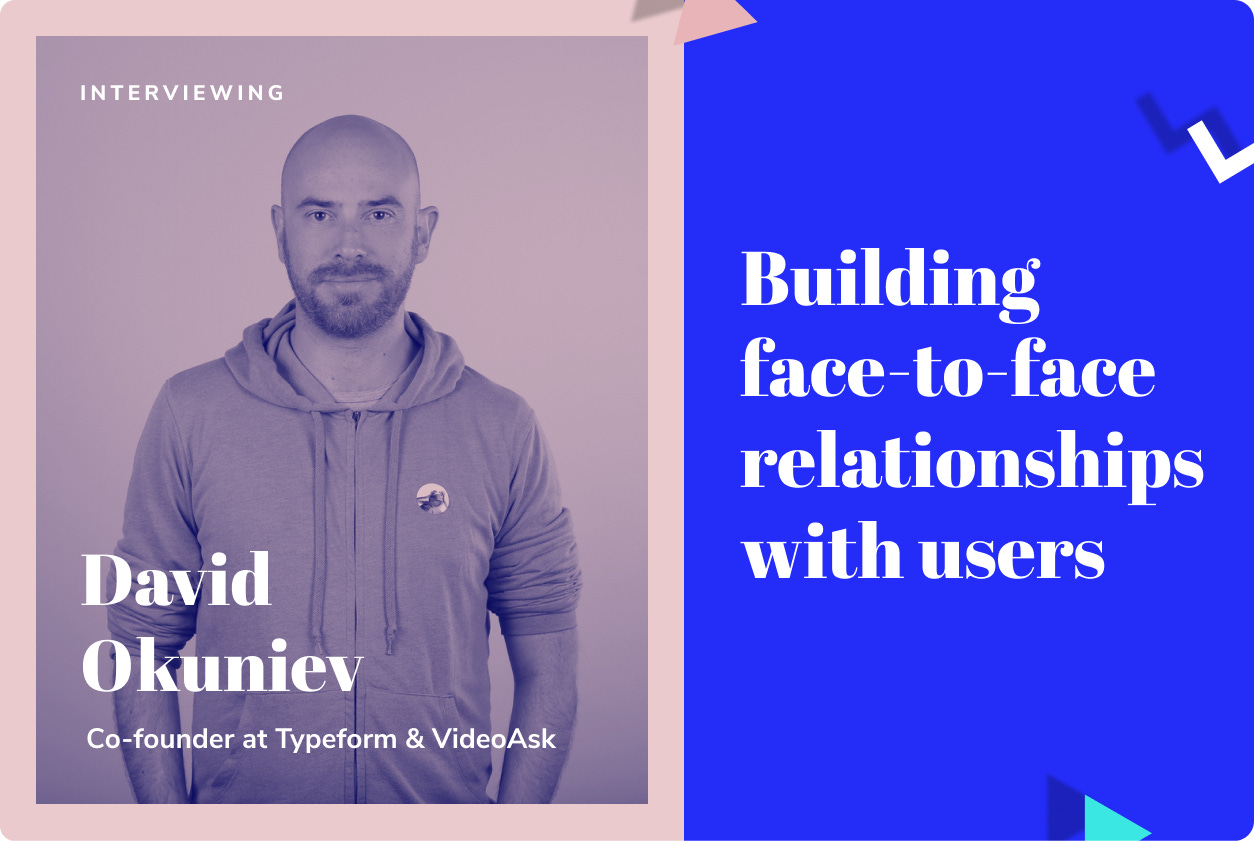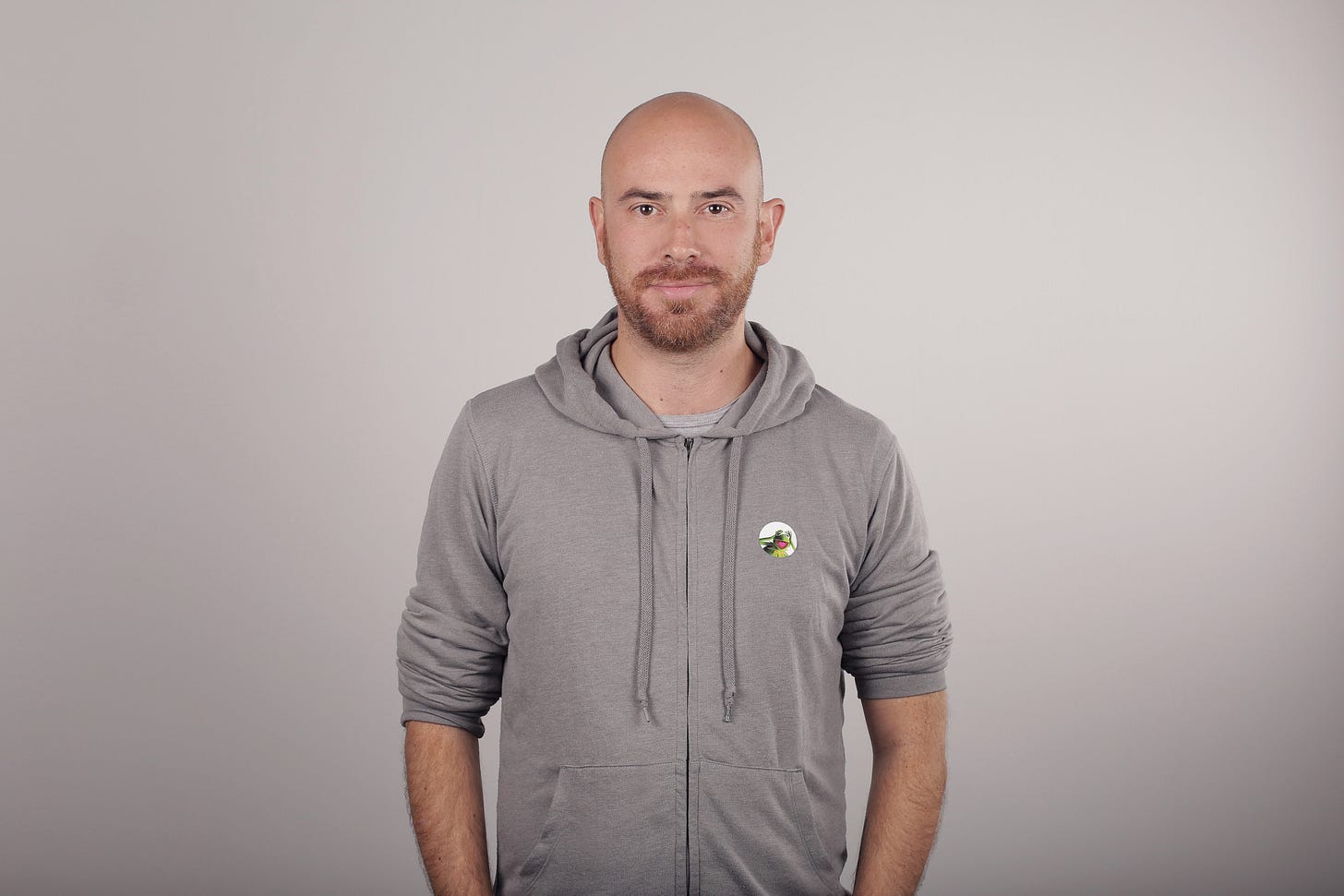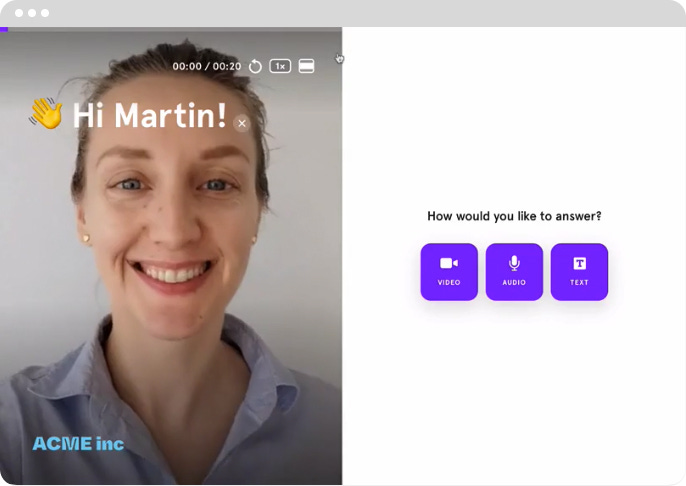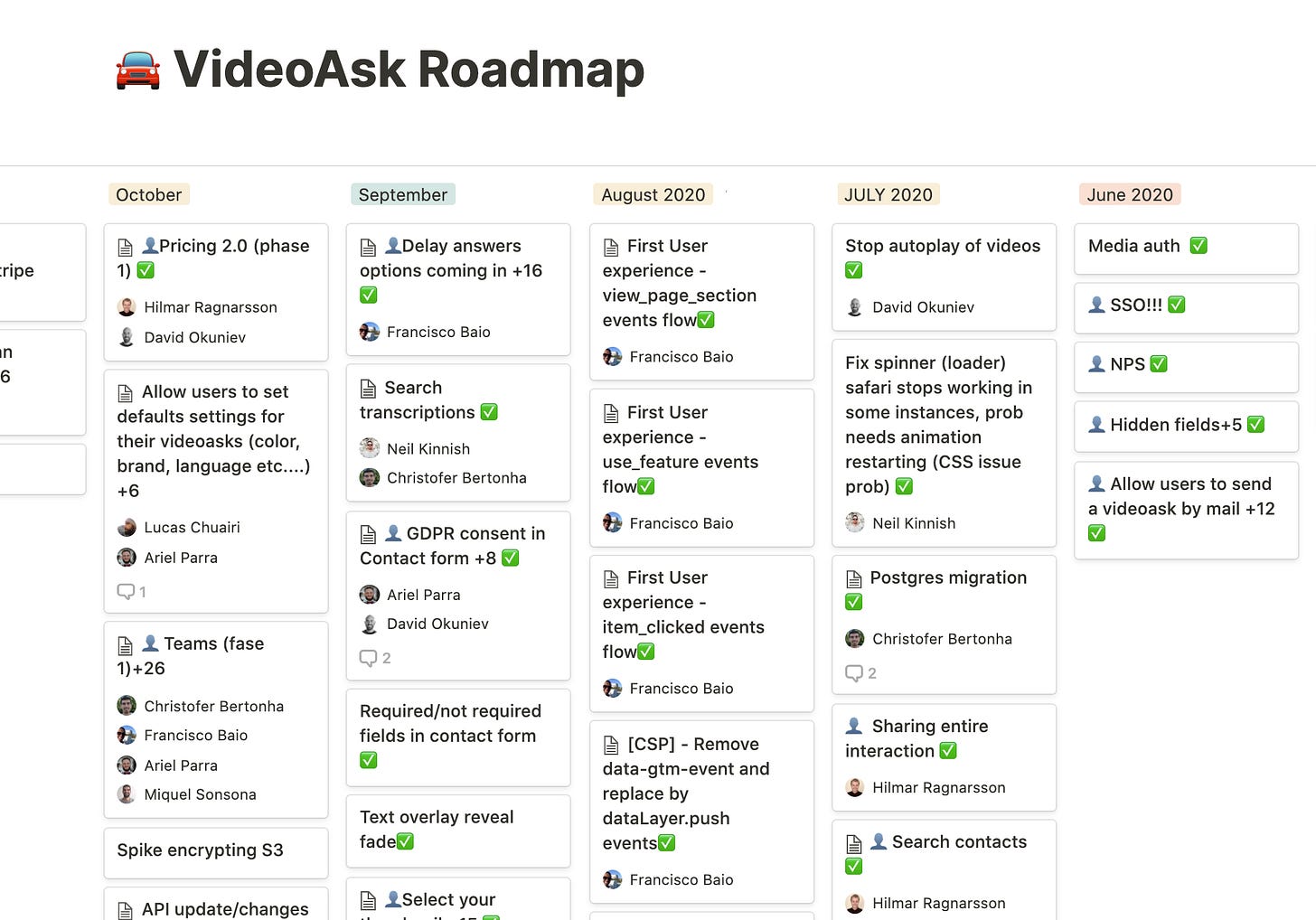Building a face-to-face relationship with users at VideoAsk (by Typeform) – Issue 2
An interview with David Okuniev, co-founder of Typeform

Welcome to the first interview on this series 👏! Today we’re talking to David Okuniev, co-founder of Typeform.
After founding Typeform and serving as co-CEO for years, David went back to his product building passion and started a new product to interact with people: VideoAsk. David explains how relationships with users are how they develop this fast-growing product.
Enjoy! To get more like this in your inbox weekly, consider subscribing 👇
What is VideoAsk and how did it start?
When founding Typeform, our goal was to get people to communicate as humanely as possible when exchanging information.
I started as a product person, my background is in product design, and then I met Robert, my co-founder. We stumbled across this idea to make forms more interactive, one question at a time. And we built a company around it which turned out pretty successful.
From the start, we were both running the company and developing the product as co-CEOs. Over the years, as the company grew bigger, I got further away from product and was doing more management stuff. I’m a hands-on guy; I like to design, code, being able to react, and being super close to the customer. If there's a customer problem, I think: “Okay, how can I solve this in my head, draw it, and then fix it and push the code to production?” I really enjoy that.

There was a point in the company's trajectory where things were getting really big. The company was around 200 people so it was time for me and Robert to step down. I decided to start doing more R&D.
The idea of VideoAsk was just an idea trickling around. The question was: “How can we make this even more human?” Typeform allows you to make things more interactive with pictures and videos, but there's nothing like your real face in terms of actually expressing something. So this idea of doing a video-centric data collection tool emerged.
Actually it merged into something quite different now compared to a form tool like Typeform. It’s an asynchronous way to interact in person with other people. So you create a VideoAsk, which can be a single question with an interaction point or a multi-step video where you can take people through a journey of questions depending on their choices. After that, you can follow up and exchange video messages. Essentially, you can continue to dig deeper and nurture a relationship.

We use VideoAsk for support for instance; Users record their video and then you have a conversation face-to-face, just like talking to them immediately. The power of that is amazing in terms of being upfront with your customers.
What was the moment you started the online community for VideoAsk and why?
We started the Slack community super early on when we were still in beta. I'm part of some Slack communities, for example, our investors interact through a slack community. So we thought it would be a good way to easily talk to customers as we built out the product.
We’re building relationships as opposed to the normal ticketing system for support.
The community members are early adopters that want to share stuff, so it's a really good way to get to learn from people. We're getting constant feedback through the community. It's also a good place to test out features and tell people: “Hey, this is what we've been thinking of”. We’re building relationships as opposed to the normal ticketing system we have for people who need support.
What are your thoughts about using Slack to run your online community?
It's a great source of feedback. It's also a place where you can advertise features for example to get things easily adopted because the people there are paying attention.
The hard thing is that you have to provide a certain level of service. We hang out in the Slack but have to be careful it doesn't become a support channel since we can't be there all the time. For support, we have a VideoAsk and that allows us to stay responsive to for example users paying for priority support. The principle: If we’re around and can answer your question, we'll answer, otherwise, try talking to other members as well. We’re starting to see people actually helping each other out inside the community.
To manage expectations, we say at the top of the channel: “This is not a life support channel, please answer the VideoAsk”. Sometimes we need to remind users that when we're around, we talk, but we're also working. Actually the entire VideoAsk team is in there so we don’t want it to look like a live support channel.
The question is: “Can we do this forever?” We're giving a high level of customer service, like, jumping on a live chat with an engineer, sometimes immediately. People get used to talking directly to us and it's gonna be hard to take that away from them as we grow.
You specifically try to prevent people from using the community as a support channel, why is that?
You can’t manage support in Slack. Also, it’s really important for us to use our own tool and create a conversation that is face-to-face. I think it’s really important that people developing the product need to stay close to the customer; you need to build empathy.
People developing the product need to stay close to the customer; you need to build empathy.
Apart from the community Slack, we have a Typeform company Slack with a channel called #videoask-help. All the support request videos go into that channel. We discuss requests with the developers as well as they come in. Because it’s all video it just creates empathy; you want to solve that person’s problem. They’re not a faceless user behind some words but actually a real person to which you feel some sense of duty.
What do you do differently now compared to the early days of Typeform?
Well, Slack didn’t exist yet, and there were probably some tools, but we weren’t on them. At the time, we were just less customer-centric, we were kind of working in a vacuum, developing the product. And to be fair that may have made Typeform what it is. I do believe that if we been getting a lot of feedback on how we should build a form, we might have gone in a different direction. We didn’t take any feedback before launching the beta.
You need to have a strong sense of what you want to achieve and have a strong vision.
I think you need to combine both. You need to have a strong sense of what you want to achieve and have a strong vision. Then getting feedback from your team and from the community allows you to make micro-adjustments on the way.
Getting other people involved helps shape your ideas. But you can spend a lot of time going to customer interviews, digesting all that and trying to crunch data. It can be valuable, but I personally just use it as input into my thought process to make the right decisions.
What kind of users are in the community and how do they find it?
The people that join the slack community really like the product, want to be involved, and stay close to the team that is building it. It’s a certain type of person who will give good feedback and such. It's a bit biased, actually, because you're not getting feedback from the not so techie person that might be just stuck in the onboarding funnel because they just don't get it.
We don't encourage joining the community too much because then there will be too many people. There are nearly 1000 people in it at this point, I don’t think we need that many to be completely honest. But we keep it open as long as it's useful and manageable. This way it's a good place to launch features early on and get great feedback if something is not quite right.
What do you do to keep things lively?
There's no one actively managing the community. It's just a place where we hang out. There's no one trying to get more people in or doing community initiatives. We just do occasional things, for example, our marketing manager was just asking if any member wanted to leave a testimonial for our website. So sometimes we exchange stuff in the community with people. But we don't watch metrics, see how it's growing, or set any targets.
How do you involve your community in improving your product?
The community is very anecdotal, right? Someone can make noise and that can unduly influence you in a direction. You have no data, you don't know how many people said the same thing. It's kind of feeding into hunches.
The community is very anecdotal. Someone can make noise and that can unduly influence you in a direction.
Our process is really simple and it allows us to ship fast. We reverse engineer the product value that we want to deliver. All I do is maintain a Notion board, kanban style. Each column is a month. I add the things that we should achieve this month in terms of user value and include a little spec inside the cards.

We also have an improvement and bug column. We reserve Fridays for shipping improvements that you can ship in a day. It's free form and the engineers can freely pick. Then we have a Prioritize ASAP column for features that we think we should do. We add plusses when actual users report those as requests inside.
To loop back, we publish a monthly product digest and we tell the users what we're going to ship next. This creates a cadence. That’s all, we have very little process and it works. We ship about 7-8 features a month with a team of initially three, now seven developers.
A piece of advice you would give to anyone that wants to build with users?
There are playbooks out there of how you should do things. I think you should try and understand your customer as well as possible, get as close as possible, and work to serve that customer.
Shed everything that gets in the way, because otherwise, you forget that you're just trying to ship value.
Shed everything that gets in the way, because otherwise, you forget that you're just trying to ship value. That's all, the customer doesn't see all your process behind.
Create a process that works for you so that you can ship the most amount of value to the customer. The more value you ship, the more you're going to be rewarded. That creates a virtuous circle and in my opinion, creates really good products.
If you get stuck trying to be completely data-centric, as opposed to data-informed, then you got to ask yourself: “have you got enough intuition about what you are doing?” It's a different school of thought, and it's just my personal personality as well. I'm a designer, I want to design things and ship them out so that people can try them.
Be a creator, acquire the skills that you need to be a creator. Understand engineering, try coding things, try designing things, you don’t have to be the designer or the coder but understand those things.
When you start something up, you can be super scrappy and you can afford to take big risks. It's fine because you're just at the start of the curve. The more mature, the more data-centric you should become.
Your favorite article or book as a community enthusiast?
I don’t read any business books, I mainly listen to podcasts. Sam Harris and Joe Rogan provide a good way to listen to good conversations.
How can we find more about you or VideoAsk?
Check out VideoAsk and give it a try. You can find David on Twitter as @okuiux.
Thanks for reading till the end 🙏
Next week we plan to have another cool interview for you 💪, stay tuned, and subscribe if you didn’t yet.
✌️ Cheers,

